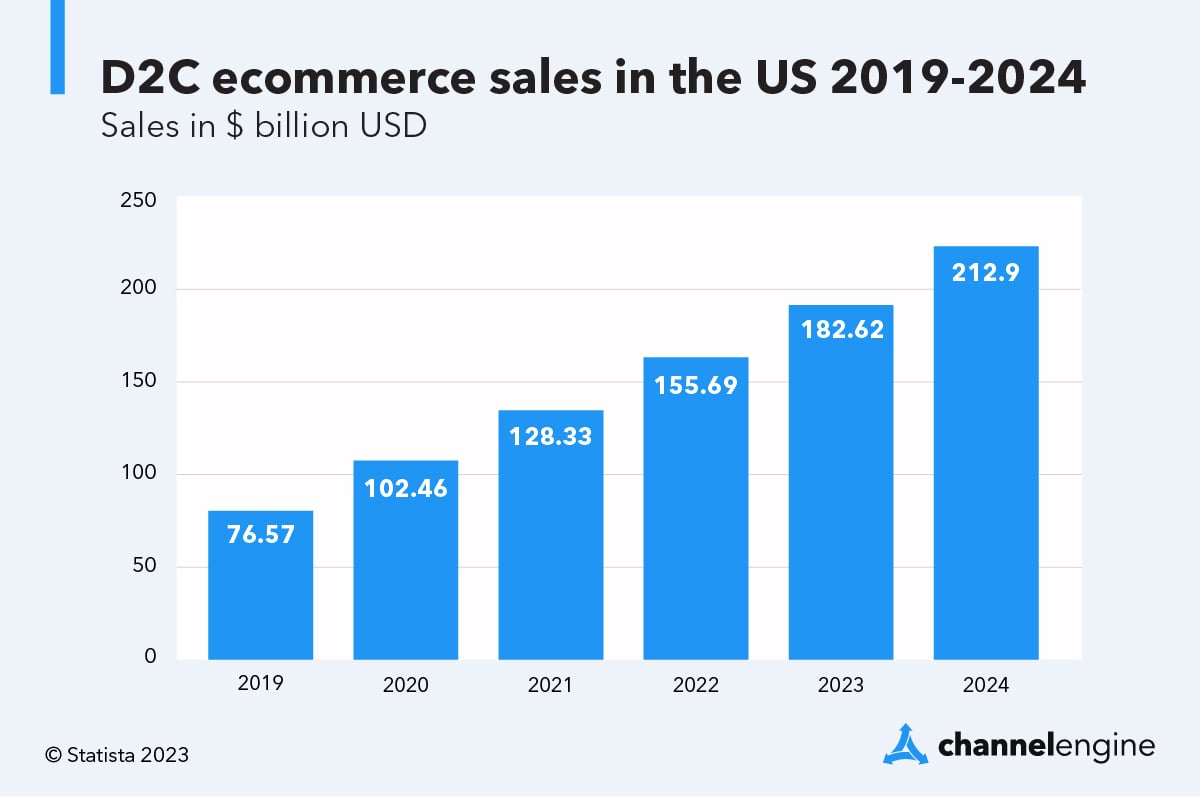From Inventory to Fulfillment: How a D2C Ecommerce Agency Streamlines Operations
Discovering the Potential of D2C Ecommerce: A Comprehensive Guide for Services
The D2C ecommerce design offers a significant change in just how brand names engage with consumers. It allows business to bypass standard retail networks, cultivating deeper links and possibly boosted profit margins. Nonetheless, this technique is not without its intricacies. Understanding the subtleties of D2C ecommerce is vital for brands intending to flourish. What approaches can they embrace to browse this advancing landscape successfully? The responses may redefine their organization methods.
Comprehending the D2C Ecommerce Design

Key Conveniences of D2C Ecommerce for Brands
The D2C ecommerce version offers brand names substantial benefits, especially pertaining to raised revenue margins. By getting rid of intermediaries, companies can preserve a bigger share of sales profits. Additionally, this straight relationship with customers cultivates improved brand name loyalty, encouraging repeat acquisitions and long-lasting interaction.
Enhanced Revenue Margins

Improved Brand Name Loyalty
Structure on the economic advantages of D2C ecommerce, improved brand name commitment becomes one more necessary advantage for business involving directly with consumers. By establishing a straight link, brands can cultivate deeper relationships with their consumers, getting understandings into choices and habits. This straight interaction permits more personalized advertising and marketing approaches, which reverberate highly with consumers. Furthermore, brands have the chance to control their messaging and client experience, strengthening brand name worths and developing trust. When consumers really feel a personal link, they are more most likely to return, promote for the brand, and take part in neighborhood interaction. Eventually, enhanced brand name loyalty not only drives repeat acquisitions yet additionally cultivates a passionate client base, additional solidifying a brand name's placement in the market.
Difficulties Dealt With by D2C Brands
D2C brands experience several significant challenges that can influence their success. Supply administration problems can result in stock scarcities or excess, complicating operations and client contentment. In addition, marketing budget restraints usually restrict the capability to efficiently engage and get to target audiences.
Supply Management Issues
Efficient inventory administration presents a powerful challenge for lots of brand names running in the direct-to-consumer (D2C) space. These brand names frequently come to grips with fluctuating demand, which can lead to overstock or stockouts, ultimately influencing customer contentment and income. Additionally, the absence of advanced supply radar can cause inconsistencies in between real supply levels and reported data, complicating order gratification. The diverse series of products D2C brand names typically provide also makes complex supply administration, as variations in designs, colors, and sizes require even more thorough oversight. Furthermore, many D2C organizations might deal with restricted warehousing abilities, causing inefficient use space and resources. Consequently, efficient stock management remains an important difficulty for D2C brand names aiming for sustainable growth and operational efficiency.
Advertising And Marketing Budget Constraints
Maneuvering advertising and marketing budget plan restraints is a considerable obstacle for several direct-to-consumer (D2C) brands. Minimal funds typically limit these firms' capacity to spend in all-inclusive advertising approaches, causing minimized visibility in an open market. D2C brand names regularly come to grips with the requirement to maximize roi (ROI) while targeting particular audiences efficiently. This obstacle is aggravated by increasing costs in electronic marketing and the need to designate funds across numerous channels, including social media, search engines, and e-mail marketing. Many D2C brand names have to introduce economical advertising services, leveraging organic growth approaches and influencer partnerships. Inevitably, successfully steering these budget plan restraints is necessary for sustaining growth and achieving lasting profitability in the advancing ecommerce landscape.
Approaches for Developing a Successful D2C Ecommerce Service
As customers significantly look for straight links with brand names, developing an effective D2C ecommerce company needs a calculated strategy that prioritizes customer involvement and trust fund. One reliable technique is to create compelling brand name stories that resonate with target audiences, cultivating emotional connections. Using social media sites systems can enhance visibility my response and promote two-way interaction, enabling brand names to engage directly with customers.Moreover, customized experiences via customized marketing efforts can substantially improve consumer retention and commitment. Applying commitment programs and offering special offers can even more incentivize repeat purchases.Streamlining the purchasing process is important, guaranteeing an easy to use interface that boosts the purchasing experience. In addition, transparent interaction relating to shipping and returns builds trust and urges consumer confidence.Finally, proactively looking for client feedback and replying to it demonstrates a dedication to enhancement and consumer satisfaction, important aspects in the competitive D2C landscape.
Leveraging Modern Technology for Enhanced Consumer Experience
In today's competitive D2C ecommerce landscape, modern technology plays a critical function fit consumer experiences. Companies significantly use advanced devices such as man-made intelligence, chatbots, and personalized algorithms to enhance communications and simplify the purchasing process. By incorporating these innovations, brands can provide tailored item recommendations based upon private choices and shopping actions, cultivating a more engaging experience.Moreover, responsive internet site layouts and mobile applications guarantee that consumers can access solutions seamlessly across various gadgets. Boosted settlement solutions, including digital pocketbooks and one-click checkouts, better simplify purchases, making it easier for consumers to make purchases.Data analytics also makes it possible for services to collect insights into client actions, permitting constant renovation of services and offerings. On the whole, leveraging technology not only improves customer fulfillment yet also cultivates commitment, inevitably driving long-lasting success in the D2C ecommerce field.
Advertising And Marketing Methods to Drive D2C Sales
Just how can brand names properly capture the focus of customers in a saturated market? To grow in the direct-to-consumer (D2C) landscape, brand names should utilize targeted advertising methods. Using social networks systems, brand names can involve consumers with interactive web content, influencer partnerships, and user-generated articles. Individualized e-mail projects can additionally cultivate a feeling of link, offering customized promos based on customer actions and preferences.Moreover, narration plays a vital role in setting apart a brand name's narrative, making it relatable and remarkable. Brand names need to buy seo (SEARCH ENGINE OPTIMIZATION) to enhance visibility, guaranteeing their items are quickly visible online. In addition, leveraging information analytics allows services to refine their marketing strategies and recognize consumer patterns much better. Eventually, a multi-channel approach that integrates creative thinking with data-driven insights can greatly enhance D2C sales, enabling brands to stick out in a congested industry.
Future Patterns in D2C Ecommerce
With the rapid development of technology and consumer choices, the future of D2C ecommerce is poised for considerable improvement. Emerging patterns indicate a shift in the direction of hyper-personalization, where brands take advantage of data analytics to customize offerings to specific customer needs. This customization boosts customer experiences, promoting commitment and engagement.Moreover, sustainability is becoming an essential variable, with consumers increasingly favoring brand names that prioritize environmentally friendly techniques - a knockout post D2C Ecommerce Agency. Companies are anticipated to embrace transparent supply chains and sustainable products to meet this demand.The integration of expert system and increased fact will in addition transform the buying experience, permitting consumers to visualize items in their settings before purchase. Additionally, social business is prepared for to expand, as systems like Instagram and TikTok assist in seamless shopping experiences directly within social media.These trends jointly represent a vibrant future for D2C ecommerce, stressing customer-centric strategies and cutting-edge technologies that redefine customer communications
Often Asked Inquiries
What Industries Benefit Many From D2C Ecommerce?
The present concern highlights industries that flourish through direct-to-consumer (D2C) ecommerce. Remarkably, fashion, beauty, electronics, and food sectors take advantage of D2C versions to increase brand loyalty, boost consumer connections, and enhance revenue margins properly.
Just How Do Delivering Prices Impact D2C Prices Methods?
Delivering prices substantially affect D2C rates approaches. Services must stabilize these costs with competitive pricing, thinking about customer assumptions and earnings margins. Reliable administration of shipping can boost customer complete satisfaction and drive sales in direct-to-consumer models.
What Payment Choices Should D2C Companies Offer?
D2C organizations ought to use varied settlement choices, consisting of credit/debit cards, electronic anchor wallets, and buy currently, pay later on solutions. This selection boosts client benefit, boosts conversion rates, and accommodates various consumer choices in the online buying landscape.
Just How Can D2C Brands Deal With Client Returns Effectively?
D2C brands can deal with client returns effectively by implementing straightforward return policies, offering pre paid shipping labels, and making certain prompt refunds (D2C Ecommerce Agency). Clear communication and structured procedures boost consumer fulfillment and encourage repeat company
What Legal Factors To Consider Exist for D2C Ecommerce Workflow?
Legal factors to consider for D2C ecommerce operations include conformity with consumer protection laws, information personal privacy laws, intellectual property legal rights, and tax needs. Brand names have to navigate these intricacies to avoid legal risks and assure smooth operations. By getting rid of middlemans, D2C brands can provide competitive rates and promote an extra intimate partnership with their customers.The D2C design is defined by its reliance on digital platforms, enabling brands to use social media, on the internet markets, and their own sites to engage with customers directly. D2C ecommerce facilitates the collection of beneficial customer information, enabling brands to tailor their offerings and marketing strategies successfully, inevitably driving sales and raising margins. In addition, brands have the chance to regulate their messaging and consumer experience, strengthening brand values and developing trust fund. As customers progressively seek direct connections with brand names, establishing an effective D2C ecommerce service needs a strategic approach that prioritizes customer interaction and trust fund. D2C brand names can manage customer returns properly by carrying out easy to use return policies, offering pre paid delivery tags, and making sure punctual refunds.